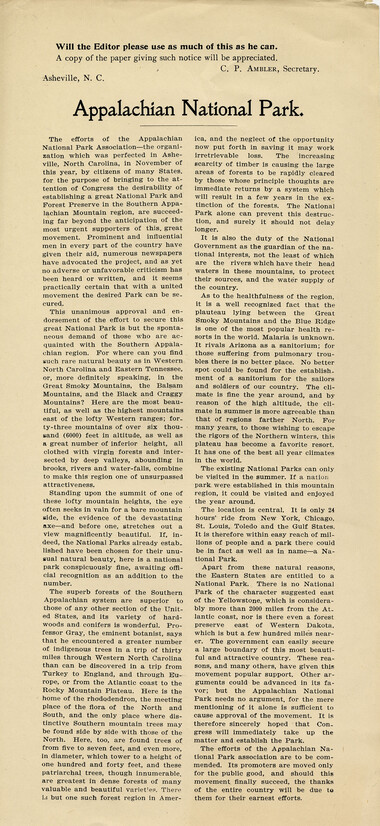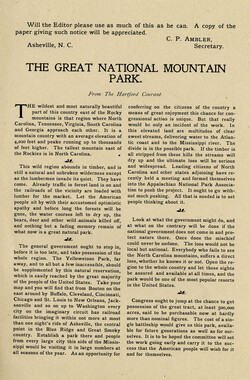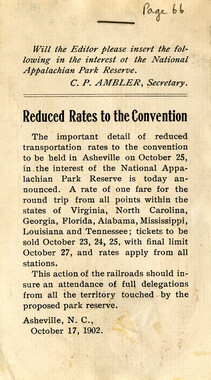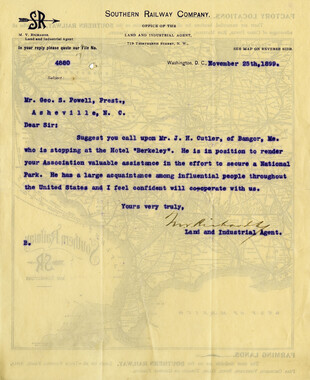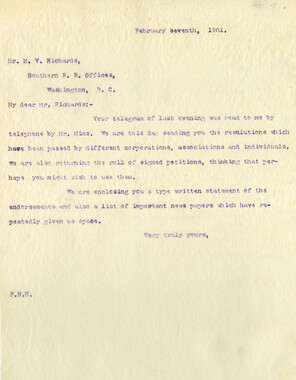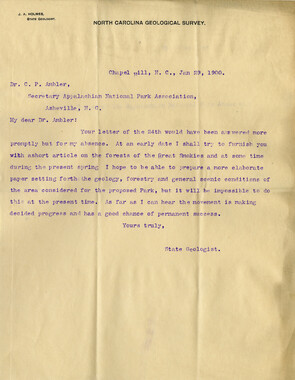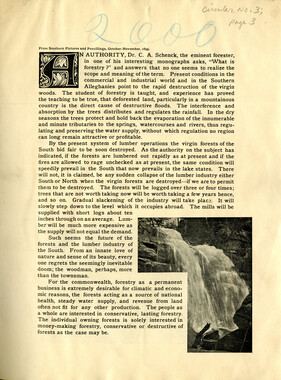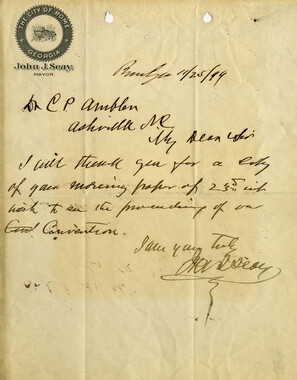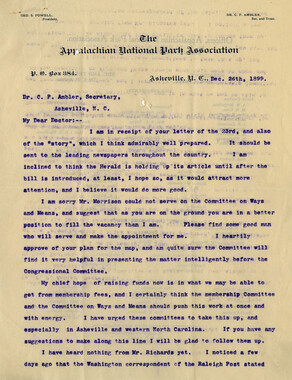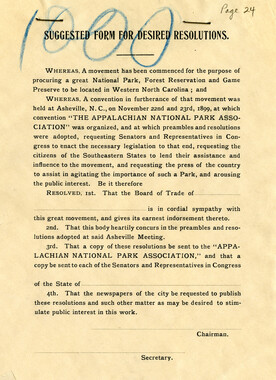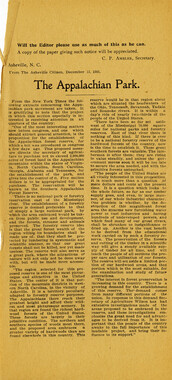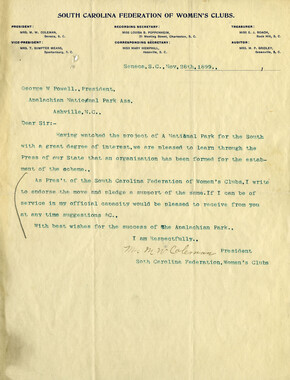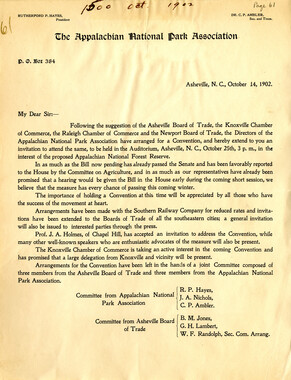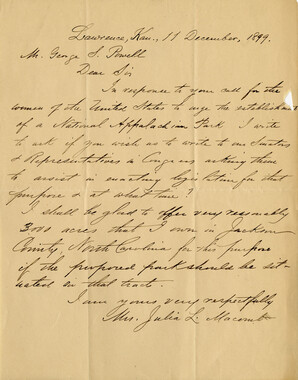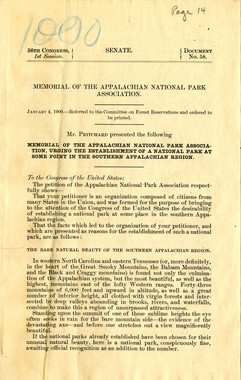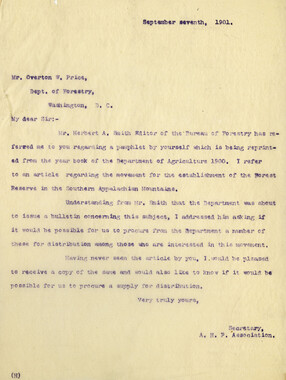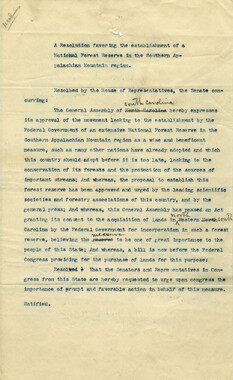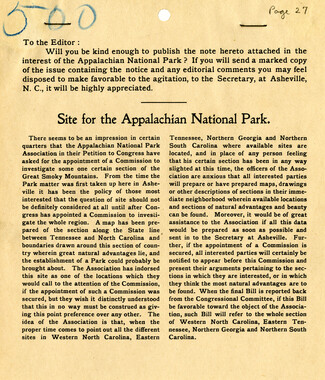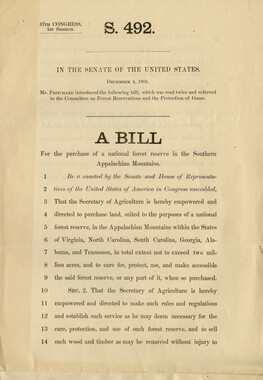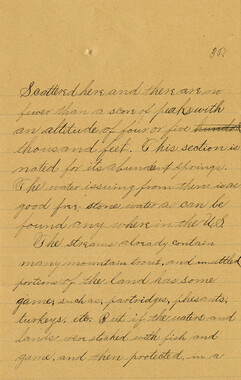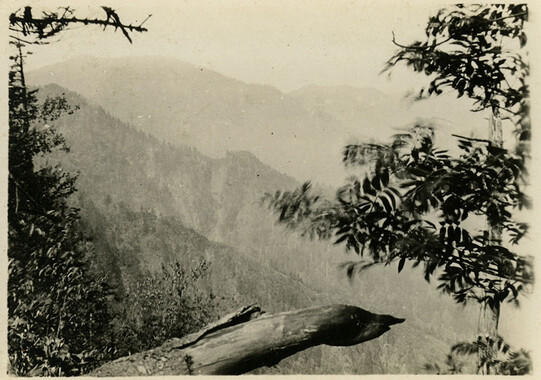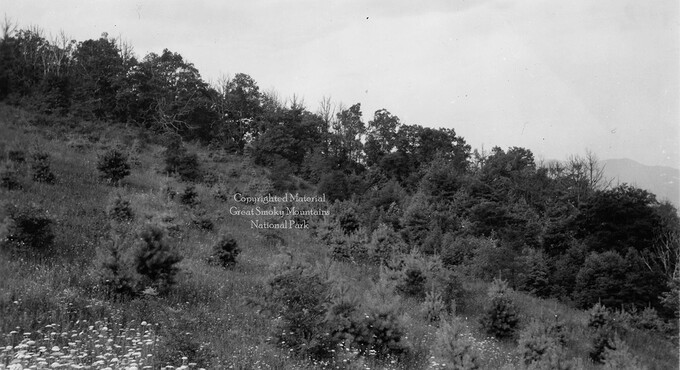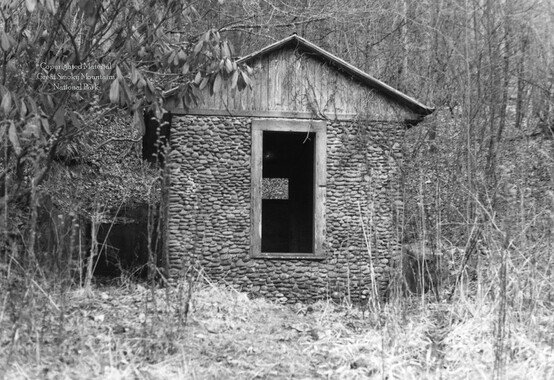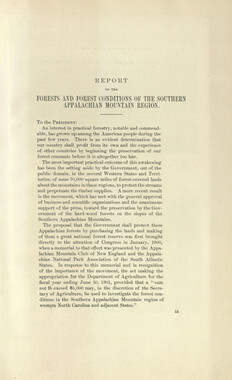Western Carolina University (20)
View all
- Canton Champion Fibre Company (2308)
- Cherokee Traditions (293)
- Civil War in Southern Appalachia (165)
- Craft Revival (1942)
- Great Smoky Mountains - A Park for America (2767)
- Highlights from Western Carolina University (430)
- Horace Kephart (941)
- Journeys Through Jackson (154)
- LGBTQIA+ Archive of Jackson County (27)
- Oral Histories of Western North Carolina (314)
- Picturing Appalachia (6772)
- Stories of Mountain Folk (413)
- Travel Western North Carolina (160)
- Western Carolina University Fine Art Museum Vitreograph Collection (129)
- Western Carolina University Herbarium (92)
- Western Carolina University: Making Memories (708)
- Western Carolina University Publications (2283)
- Western Carolina University Restricted Electronic Theses and Dissertations (146)
- Western North Carolina Regional Maps (71)
- World War II in Southern Appalachia (131)
University of North Carolina Asheville (6)
View all
- Allanstand Cottage Industries (62)
- Appalachian National Park Association (53)
- Bennett, Kelly, 1890-1974 (1388)
- Berry, Walter (76)
- Brasstown Carvers (40)
- Carver, George Washington, 1864?-1943 (26)
- Cathey, Joseph, 1803-1874 (1)
- Champion Fibre Company (233)
- Champion Paper and Fibre Company (297)
- Cherokee Indian Fair Association (16)
- Cherokee Language Program (22)
- Crowe, Amanda (40)
- Edmonston, Thomas Benton, 1842-1907 (7)
- Ensley, A. L. (Abraham Lincoln), 1865-1948 (275)
- Fromer, Irving Rhodes, 1913-1994 (70)
- George Butz (BFS 1907) (46)
- Goodrich, Frances Louisa (120)
- Grant, George Alexander, 1891-1964 (96)
- Heard, Marian Gladys (60)
- Kephart, Calvin, 1883-1969 (15)
- Kephart, Horace, 1862-1931 (313)
- Kephart, Laura, 1862-1954 (39)
- Laney, Gideon Thomas, 1889-1976 (439)
- Masa, George, 1881-1933 (61)
- McElhinney, William Julian, 1896-1953 (44)
- Niggli, Josephina, 1910-1983 (10)
- North Carolina Park Commission (105)
- Osborne, Kezia Stradley (9)
- Owens, Samuel Robert, 1918-1995 (11)
- Penland Weavers and Potters (36)
- Roberts, Vivienne (15)
- Roth, Albert, 1890-1974 (142)
- Schenck, Carl Alwin, 1868-1955 (1)
- Sherrill's Photography Studio (2565)
- Southern Highland Handicraft Guild (127)
- Southern Highlanders, Inc. (71)
- Stalcup, Jesse Bryson (46)
- Stearns, I. K. (213)
- Thompson, James Edward, 1880-1976 (226)
- United States. Indian Arts and Crafts Board (130)
- USFS (683)
- Vance, Zebulon Baird, 1830-1894 (1)
- Weaver, Zebulon, 1872-1948 (58)
- Western Carolina College (230)
- Western Carolina Teachers College (282)
- Western Carolina University (1794)
- Western Carolina University. Mountain Heritage Center (18)
- Whitman, Walt, 1819-1892 (10)
- Wilburn, Hiram Coleman, 1880-1967 (73)
- Williams, Isadora (3)
- Cain, Doreyl Ammons (0)
- Crittenden, Lorraine (0)
- Rhodes, Judy (0)
- Smith, Edward Clark (0)
- Appalachian Region, Southern (2399)
- Asheville (N.C.) (1917)
- Avery County (N.C.) (26)
- Blount County (Tenn.) (161)
- Buncombe County (N.C.) (1671)
- Cherokee County (N.C.) (283)
- Clay County (N.C.) (555)
- Graham County (N.C.) (233)
- Great Smoky Mountains National Park (N.C. and Tenn.) (510)
- Haywood County (N.C.) (3522)
- Henderson County (N.C.) (70)
- Jackson County (N.C.) (4692)
- Knox County (Tenn.) (25)
- Knoxville (Tenn.) (12)
- Lake Santeetlah (N.C.) (10)
- Macon County (N.C.) (420)
- Madison County (N.C.) (211)
- McDowell County (N.C.) (39)
- Mitchell County (N.C.) (132)
- Polk County (N.C.) (35)
- Qualla Boundary (981)
- Rutherford County (N.C.) (76)
- Swain County (N.C.) (2113)
- Transylvania County (N.C.) (270)
- Watauga County (N.C.) (12)
- Waynesville (N.C.) (73)
- Yancey County (N.C.) (72)
- Aerial Photographs (3)
- Aerial Views (60)
- Albums (books) (4)
- Articles (1)
- Artifacts (object Genre) (228)
- Bibliographies (1)
- Biography (general Genre) (2)
- Cards (information Artifacts) (38)
- Clippings (information Artifacts) (191)
- Crafts (art Genres) (622)
- Depictions (visual Works) (21)
- Design Drawings (1)
- Drawings (visual Works) (184)
- Envelopes (73)
- Facsimiles (reproductions) (1)
- Fiction (general Genre) (4)
- Financial Records (12)
- Fliers (printed Matter) (67)
- Glass Plate Negatives (381)
- Guidebooks (2)
- Internegatives (10)
- Interviews (812)
- Land Surveys (102)
- Letters (correspondence) (1013)
- Manuscripts (documents) (619)
- Maps (documents) (177)
- Memorandums (25)
- Minutes (administrative Records) (59)
- Negatives (photographs) (5835)
- Newsletters (1285)
- Newspapers (2)
- Occupation Currency (1)
- Paintings (visual Works) (1)
- Pen And Ink Drawings (1)
- Periodicals (193)
- Personal Narratives (10)
- Photographs (12976)
- Plans (maps) (1)
- Poetry (7)
- Portraits (1960)
- Postcards (329)
- Programs (documents) (151)
- Publications (documents) (2237)
- Questionnaires (65)
- Scrapbooks (282)
- Sheet Music (2)
- Slides (photographs) (402)
- Songs (musical Compositions) (2)
- Sound Recordings (796)
- Specimens (92)
- Speeches (documents) (15)
- Tintypes (photographs) (8)
- Transcripts (322)
- Video Recordings (physical Artifacts) (23)
- Vitreographs (129)
- Text Messages (0)
- A.L. Ensley Collection (275)
- Appalachian Industrial School Records (7)
- Appalachian National Park Association Records (336)
- Axley-Meroney Collection (2)
- Bayard Wootten Photograph Collection (20)
- Bethel Rural Community Organization Collection (7)
- Blumer Collection (5)
- C.W. Slagle Collection (20)
- Canton Area Historical Museum (2110)
- Carlos C. Campbell Collection (282)
- Cataloochee History Project (65)
- Cherokee Studies Collection (4)
- Daisy Dame Photograph Album (5)
- Daniel Boone VI Collection (1)
- Doris Ulmann Photograph Collection (112)
- Elizabeth H. Lasley Collection (1)
- Elizabeth Woolworth Szold Fleharty Collection (4)
- Frank Fry Collection (95)
- George Masa Collection (173)
- Gideon Laney Collection (452)
- Hazel Scarborough Collection (2)
- Hiram C. Wilburn Papers (28)
- Historic Photographs Collection (236)
- Horace Kephart Collection (861)
- Humbard Collection (33)
- Hunter and Weaver Families Collection (1)
- I. D. Blumenthal Collection (4)
- Isadora Williams Collection (4)
- Jesse Bryson Stalcup Collection (47)
- Jim Thompson Collection (224)
- John B. Battle Collection (7)
- John C. Campbell Folk School Records (80)
- John Parris Collection (6)
- Judaculla Rock project (2)
- Kelly Bennett Collection (1407)
- Love Family Papers (11)
- Major Wiley Parris Civil War Letters (3)
- Map Collection (12)
- McFee-Misemer Civil War Letters (34)
- Mountain Heritage Center Collection (4)
- Norburn - Robertson - Thomson Families Collection (44)
- Pauline Hood Collection (7)
- Pre-Guild Collection (2)
- Qualla Arts and Crafts Mutual Collection (12)
- R.A. Romanes Collection (681)
- Rosser H. Taylor Collection (1)
- Samuel Robert Owens Collection (94)
- Sara Madison Collection (144)
- Sherrill Studio Photo Collection (2558)
- Smoky Mountains Hiking Club Collection (616)
- Stories of Mountain Folk - Radio Programs (374)
- The Reporter, Western Carolina University (510)
- Venoy and Elizabeth Reed Collection (16)
- WCU Gender and Sexuality Oral History Project (32)
- WCU Mountain Heritage Center Oral Histories (25)
- WCU Oral History Collection - Mountain People, Mountain Lives (71)
- WCU Students Newspapers Collection (1744)
- Western North Carolina Tomorrow Black Oral History Project (69)
- William Williams Stringfield Collection (2)
- Zebulon Weaver Collection (109)
- African Americans (390)
- Appalachian Trail (35)
- Artisans (521)
- Cherokee art (84)
- Cherokee artists -- North Carolina (10)
- Cherokee language (21)
- Cherokee pottery (101)
- Cherokee women (208)
- Church buildings (167)
- Civilian Conservation Corps (U.S.) (110)
- College student newspapers and periodicals (1830)
- Dams (103)
- Dance (1023)
- Education (222)
- Floods (61)
- Folk music (1015)
- Forced removal, 1813-1903 (2)
- Forest conservation (220)
- Forests and forestry (1058)
- Gender nonconformity (4)
- Great Smoky Mountains National Park (N.C. and Tenn.) (181)
- Hunting (38)
- Landscape photography (10)
- Logging (103)
- Maps (84)
- Mines and mineral resources (8)
- North Carolina -- Maps (18)
- Paper industry (38)
- Postcards (255)
- Pottery (135)
- Railroad trains (71)
- Rural electrification -- North Carolina, Western (3)
- School integration -- Southern States (2)
- Segregation -- North Carolina, Western (5)
- Slavery (5)
- Sports (452)
- Storytelling (245)
- Waterfalls -- Great Smoky Mountains (N.C. and Tenn.) (66)
- Weaving -- Appalachian Region, Southern (280)
- Wood-carving -- Appalachian Region, Southern (328)
- World War, 1939-1945 (173)
Editorial: Appalachian National Park
-
In promoting a national park in the southern Appalachians, Chase Ambler wrote dozens of editorials and submitted them to newspapers and magazines throughout the east coast. After the editorials were published, the Appalachian National Park Association often reprinted and circulated them as part of their promotional campaign. From notes written on a copy of this one, it appears that 5000 copies of this editorial were made. Chase P. Ambler (1865-1932) was a founding member and long-time secretary of the association.
-
-
Will the Editor please use as much of this as he can. A copy of the paper giving such notice will be appreciated. C. P. Ambler, Secretary. Asheville, N. C. Appalachian National Park* The efforts of the Appalachian National Park Association—the organization which was perfected in Asheville, North Carolina, in November of this year, by citizens of many States, for the purpose of bringing to the attention of Congress the desirability of establishing a great National Park and Forest Preserve in the Southern Appalachian Mountain region, are succeeding far beyond the anticipation of the most urgent supporters of this, great movement. Prominent and influential men in every part of the country have given their aid, numerous newspapers have advocated the project, and as yet no adverse or unfavorable criticism has been heard or written, and it seems practically certain that with a united movement the desired Park can be secured. This unanimous approval and endorsement of the effort to secure this great National Park is but the spontaneous demand of those who are acquainted with the Southern Appalachian region. For where can you And such rare natural beauty as in Western North Carolina and Eastern Tennessee, or, more definitely speaking, in the Great Smoky Mountains, the Balsam Mountains, and the Black and Craggy Mountains? Here are the most beautiful, as well as the highest mountains east of the lofty Western ranges; forty-three mountains of over six thousand (6000) feet in altitude, as well as a great number of inferior height, all clothed with virgin forests and intersected by deep valleys, abounding in brooks, rivers and water-falls, combine to make this region one of unsurpassed attractiveness. Standing upon the summit of one of these lofty mountain heights, the eye often seeks in vain for a bare mountain side, the evidence of the devastating axe—and before one, stretches out a view magnificently beautiful. If, indeed, the National Parks already established have been chosen for their unusual natural beauty, here is a national park conspicuously fine, awaiting official recognition as an addition to the number. The superb forests of the Southern Appalachian system are superior to those of any other section of the United States, and its variety of hardwoods and conifers is wonderful. Professor Gray, the eminent botanist, says that he encountered a greater number of indigenous trees in a trip of thirty miles through Western North Carolina than can be discovered in a trip from Turkey to England, and through Europe, or from the Atlantic coast to the Rocky Mountain Plateau. Here is the home of the rhododendron, the meeting place of the flora of the North and South, and the only place where distinctive Southern mountain trees may be found side by side with those of the North. Here, too, are found trees of from five to seven feet, and even more, in diameter, which tower to a height of one hundred and forty feet, and these patriarchal trees, though innumerable, are greatest in dense forests of many valuable and beautiful varieties. There i.i but one such forest region in Amer ica, and the neglect of the opportunity now put forth in saving it may work irretrievable loss. The increasing scarcity of timber is causing the large areas of forests to be rapidly cleared by those whose principle thoughts are immediate returns by a system which will result in a few years in the extinction of the forests. The National Park alone can prevent this destruction, and surely it should not delay longer. It is also the duty of the National Government as the guardian of the national interests, not the least of which are the rivers which have their head waters in these mountains, to protect their sources, and the water supply of the country. As to the healthfulness of the region, it is a well recognized fact that the plauteau lying between the Great Smoky Mountains and the Blue Ridge is one of the most popular health resorts in the world. Malaria is unknown. It rivals Arizona as a sanitorium; for those suffering from pulmonary troubles there is no better place. No better spot could be found for the establishment of a sanitorium for the sailors and soldiers of our country. The climate is fine the year around, and by reason of the high altitude, the climate in summer is more agreeable than that of regions farther North. For many years, to those wishing to escape the rigors of the Northern winters, this plateau has become a favorite resort. It has one of the best all year climates in the world. The existing National Parks can only be visited in the summer. If a nation park were established in this mountain region, it could be visited and enjoyed the year around. The location is central. It is only 24 hours' ride from New York, Chicago, St. Louis, Toledo and the Gulf States. It is therefore within easy reach of millions of people and a park there could be in fact as well as in name—a National Park. Apart from these natural reasons, the Eastern States are entitled to a National Park. There is no National Park of the character suggested east of the Yellowstone, which is considerably more than 2000 miles from the Atlantic coast, nor is there even a forest preserve east of Western Dakota, which is but a few hundred miles nearer. The government can easily secure a large boundary of this most beautiful and attractive country. These reasons, and many others, have given this movement popular support. Other arguments could be advanced in its favor; but the Appalachian National Park needs no argument, for the mere mentioning of it alone is sufficient to cause approval of the movement. It is therefore sincerely hoped that Congress will immediately take up the matter and establish the Park. The efforts of the Appalachian National Park association are to be commended. Its promoters are moved only for the public good, and should this movement, finally succeed, the thanks of the entire country will be due to them for their earnest efforts.
